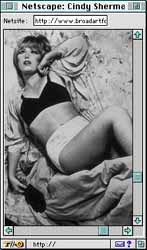L'edicola digitale delle riviste italiane di arte e cultura contemporanea
Flash Art Int. (1999 - 2001) Anno 33 Numero 212 May-June 2000
Sexually Explicit Art
Grady T. Turner
Art and Pornography

Franz Ackermann
Wolf-Günter Thiel and Milena Nikolova
n. 216 Jan-Feb 2001
Shangai Biennale
Satoru Nagoya
n. 216 January-February 2001
Aperto Albania
Edi Muka
n. 216 January-February 2001
Cecily Brown and Odili Donald Odita
n. 215 November-December 2000
Cai Guo-Qiang
Evelyne Jouanno
n. 215 November-December 2000
Aperto New York
Grady T. Turner
n. 213 summer 2000



I was in Noritoshi Hirakawa's studio recently looking at catalogues of his past exhibits when he handed me a large book opened to a group of small black and white photographs. When I asked if this was his work, he shook his head and asked if I recognized the photographer.
I looked closer at the page. The photos were dark and amateurish, and featured a woman having sex with a man. Or was it several men? As I tried to distinguish between the entangled bodies, I noticed the distinctive v-shape of the woman's lipstick. 'Wow, is that Kiki de Montparnasse?' I gasped. Though I recognized the features and body of the legendary artist's model of 1920s bohemian Paris, it had never occurred to me that there might be such explicit photos of her.
Yes, said Hirakawa, and the photographer was Man Ray. I was shocked, but then again, not surprised. I knew that Kiki had been Man Ray's lover for several years (she posed for his famous Le violin d'Ingres, in which her nude back was adorned by the
curlicues of violin sound holes), and I knew the sexual mores of the Dada group. So why should I be surprised if Man Ray
photographed himself (or other men) with Kiki? Still, this was one of those moments that Roland Barthes referred to as punctum, a puncture of art that pricks the viewer with the underlying reality of the photographed moment.
Looking at this pictures, I saw the theory stripped from art history's reading of the sexuality of Dada and Surrealism. If this was Kiki's mouth and body, if this was Man Ray's erection or Duchamp's skinny ass, then all the talk about Freud and
the creative subconscious is mere icing on the cake.
Artists concerned with bypassing the strictures of the superego naturally appreciated that sex is the fast train to the id.
It was appropriate that Hirakawa provided my education about Man Ray's secret smut. Hirakawa's art is actually rather varied, but he is best known for photographing young women engaging in prohibited activities in public places.
Women squat to piss on the street, strip in city parks or surreptitiously screw their boyfriends in office plazas.
Trained as a sociologist, Hirakawa says he never uses models or coerces his collaborators; he simply talks with women and offers them the opportunity to pose.
Of course, Man Ray's dirty pictures and Hirakawa's voyeurism are not unprecedented dalliances between art and pornography. From Titian to Fragonard, from Cabanal to Picasso, artists have always appreciated the power of eroticism. (A friend once said that his college art history text, Helen Gardner's Art
Through the Ages, remains his favorite piece of erotic literature.) By the time Andy Warhol produced silkscreens of male hustlers and Hannah Wilke and Robert Morris exhibited their bodies as fetishized objects of desire, it was apparent that artists had taken a critical interest in porn. By the time Jeff Koons posed for erotic paintings with his wife, porn
star Cicciolina, the marriage of art and porn seemed secure.
Erotically charged imagery is now common enough, but artists may still see their art misconstrued, a reminder that it wasn't so long ago that Robert Mapplethorpe and Karen Finley were made household names by conservative U.S. congressmen intent on killing funding for the arts. So it is that in a recent article on so-called 'bad girl' artists Cecily Brown, Sue Williams,
Lisa Yuskavage, and Sam Taylor-Wood, The New York Times Magazine obscured the artists' work with the black bars used to censor porn.
The gesture verged on the ridiculous 'especially in the cases of Brown and Williams, who were represented by abstract paintings' but the censorship made its point. Nearly a century after Picasso's Demoiselles d'Avignon, art's relationship
with eroticism remains charged. This is especially true of sexually explicit imagery, already a leitmotif of modern art when Man Ray took his snapshots of Kiki. Many contemporary artists challenge Judge Learned Hand's famous definition of porn: 'I may not know what it is, but I know it when I see it. 'Glen Ligon has appropriated albums of amateur porn featuring
people who might be your next door neighbors. Cindy Sherman has used prosthetics and manipulated dolls to create exploitative
scenarios. Yuskavage and John Currin have painted big-breasted bimbos resembling pin-ups. Following the example of Nan Goldin, Wolfgang Tillmans, and Nick Wapplington have made diaristic photo series documenting the sexual activities of themselves and their acquaintances. Two generations ago, Judge Hand might have distinguished porn and art as polar opposites. Porn debases, art uplifts. Porn is commercial, art is moral. Porn is cheaply produced, art is concerned with quality.
Porn feeds fantasy, art fixes reality. For the current generation of artists born during the feminist revolution, sexually active in the age of AIDS, and dubious of claims about art's special prerogatives porn provides the esthetics and vocabulary
for critiquing social attitudes about art, sex, gender, and the body. In their art, one can detect echoes of Barthes's punctum: it is precisely porn's puncturing of art, its direct engagement with reality, that attracts many artists. (to be continued)


